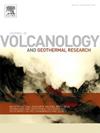Geochemical characterisation of major silicic explosive eruptions from the Azores in the last ∼100 kyrs
IF 2.3
3区 地球科学
Q2 GEOSCIENCES, MULTIDISCIPLINARY
Journal of Volcanology and Geothermal Research
Pub Date : 2025-09-15
DOI:10.1016/j.jvolgeores.2025.108446
引用次数: 0
Abstract
Volcanoes in the Azores have experienced large, silicic explosive eruptions, and these events have been concentrated mostly on the islands of São Miguel and Terceira. It is evident these eruptions are capable of dispersing tephra thousands of kilometers, owing to distal sedimentary sequences in Europe and Africa recording tephra sourced from the Azores, but the lack of detailed glass geochemical datasets precluded robust distal correlations to specific eruptions. Establishing the glass compositions of these large pyroclastic deposits will allow these Azores tephra to serve as chronostratigraphic markers. Here we present the major and trace element glass geochemical compositions of the largest known eruptions from Sete Cidades, Fogo, and Furnas volcanoes on São Miguel, and Pico Alto/Guilherme Moniz on Terceira. The glasses are predominately trachytic with 60.5–67.5 wt% SiO2, 12–19 wt% Al2O3, 1–7 wt% FeOt, Eu <6.5 ppm, Zr <2400 ppm, and Yb <14 ppm. A notable feature is that the glass compositions of individual deposits are diverse, and often show distinct populations that are associated with different eruption phases. The melts erupted from central volcanoes on both islands are distinctive - glasses erupted from São Miguel contain distinctively lower FeOt (<4.0 wt%), and higher Al2O3 (>16.8 wt%) and La/Y ratios (>1.6 ppm) relative to those erupted from Terceira. The dataset was used to establish that a cryptotephra layer in the Taforalt archaeological site in Morocco is linked to the 18-20 cal. ka BP Santa Bárbara eruption from Sete Cidades volcano >2000 km away. Interestingly, despite several tephra layers from the Azores being identified in Holocene sequences across Europe, there are no voluminous deposits on the Azores, except for Fogo A, within this timeframe. This confirms that the tephra is widely dispersed even in some of the smaller eruptions and this geochemical dataset provides a useful framework for identifying Azores tephra in Late Pleistocene distal records. However, the Azores volcanoes typically erupt compositionally diverse evolved melts that do not vary much between successive eruptions. Thus, it is often difficult to distinguish the eruption deposits based on glass compositions alone, and often chronostratigraphic information is also required to reliably correlate distal tephra to specific eruptions.
亚速尔群岛近100年来主要硅质爆炸喷发的地球化学特征
亚速尔群岛的火山经历了大规模的硅质爆炸性喷发,这些事件主要集中在米格尔岛和特塞拉岛。很明显,由于欧洲和非洲的远端沉积序列记录了来自亚速尔群岛的天热辐射,这些火山喷发能够将天热辐射扩散数千公里,但缺乏详细的玻璃地球化学数据集,因此无法与具体的火山喷发建立强有力的远端相关性。确定这些大型火山碎屑沉积物的玻璃成分,将使这些亚速尔群岛的岩浆岩可以作为年代地层标志。在这里,我们展示了已知最大喷发的主要和微量元素玻璃地球化学成分,这些喷发来自于米格尔火山上的塞特·Cidades、Fogo和Furnas火山,以及Terceira上的Pico Alto/Guilherme Moniz火山。玻璃主要为粗晶态,SiO2含量为60.5-67.5 wt%, Al2O3含量为12-19 wt%, FeOt含量为1-7 wt%, Eu <6.5 ppm, Zr <2400 ppm, Yb <14 ppm。一个显著的特征是单个沉积物的玻璃成分是多样的,并且经常显示与不同喷发阶段相关的不同种群。两个岛的中心火山喷发出的熔体是独特的——与特塞拉岛喷发出的相比,从米格尔火山喷发出的玻璃含有明显较低的FeOt (<4.0 wt%),较高的Al2O3 (>16.8 wt%)和La/Y比值(>1.6 ppm)。该数据集用于确定摩洛哥Taforalt考古遗址的隐层与2000公里外的Sete Cidades火山爆发的18-20 cal.ka BP Santa Bárbara火山爆发有关。有趣的是,尽管在整个欧洲的全新世序列中发现了亚速尔群岛的几层沥青层,但在这段时间内,除了Fogo A外,亚速尔群岛上没有大量的沉积物。这证实了即使在一些较小的火山喷发中也广泛分布着温体,该地球化学数据集为识别晚更新世远端记录中的亚速尔群岛温体提供了有用的框架。然而,亚速尔群岛的火山通常会喷发出成分多样的熔融物,在连续的喷发之间变化不大。因此,仅根据玻璃成分很难区分喷发沉积物,而且通常还需要年代地层信息来可靠地将远端火山与特定喷发联系起来。
本文章由计算机程序翻译,如有差异,请以英文原文为准。
求助全文
约1分钟内获得全文
求助全文
来源期刊
CiteScore
5.90
自引率
13.80%
发文量
183
审稿时长
19.7 weeks
期刊介绍:
An international research journal with focus on volcanic and geothermal processes and their impact on the environment and society.
Submission of papers covering the following aspects of volcanology and geothermal research are encouraged:
(1) Geological aspects of volcanic systems: volcano stratigraphy, structure and tectonic influence; eruptive history; evolution of volcanic landforms; eruption style and progress; dispersal patterns of lava and ash; analysis of real-time eruption observations.
(2) Geochemical and petrological aspects of volcanic rocks: magma genesis and evolution; crystallization; volatile compositions, solubility, and degassing; volcanic petrography and textural analysis.
(3) Hydrology, geochemistry and measurement of volcanic and hydrothermal fluids: volcanic gas emissions; fumaroles and springs; crater lakes; hydrothermal mineralization.
(4) Geophysical aspects of volcanic systems: physical properties of volcanic rocks and magmas; heat flow studies; volcano seismology, geodesy and remote sensing.
(5) Computational modeling and experimental simulation of magmatic and hydrothermal processes: eruption dynamics; magma transport and storage; plume dynamics and ash dispersal; lava flow dynamics; hydrothermal fluid flow; thermodynamics of aqueous fluids and melts.
(6) Volcano hazard and risk research: hazard zonation methodology, development of forecasting tools; assessment techniques for vulnerability and impact.

 求助内容:
求助内容: 应助结果提醒方式:
应助结果提醒方式:


